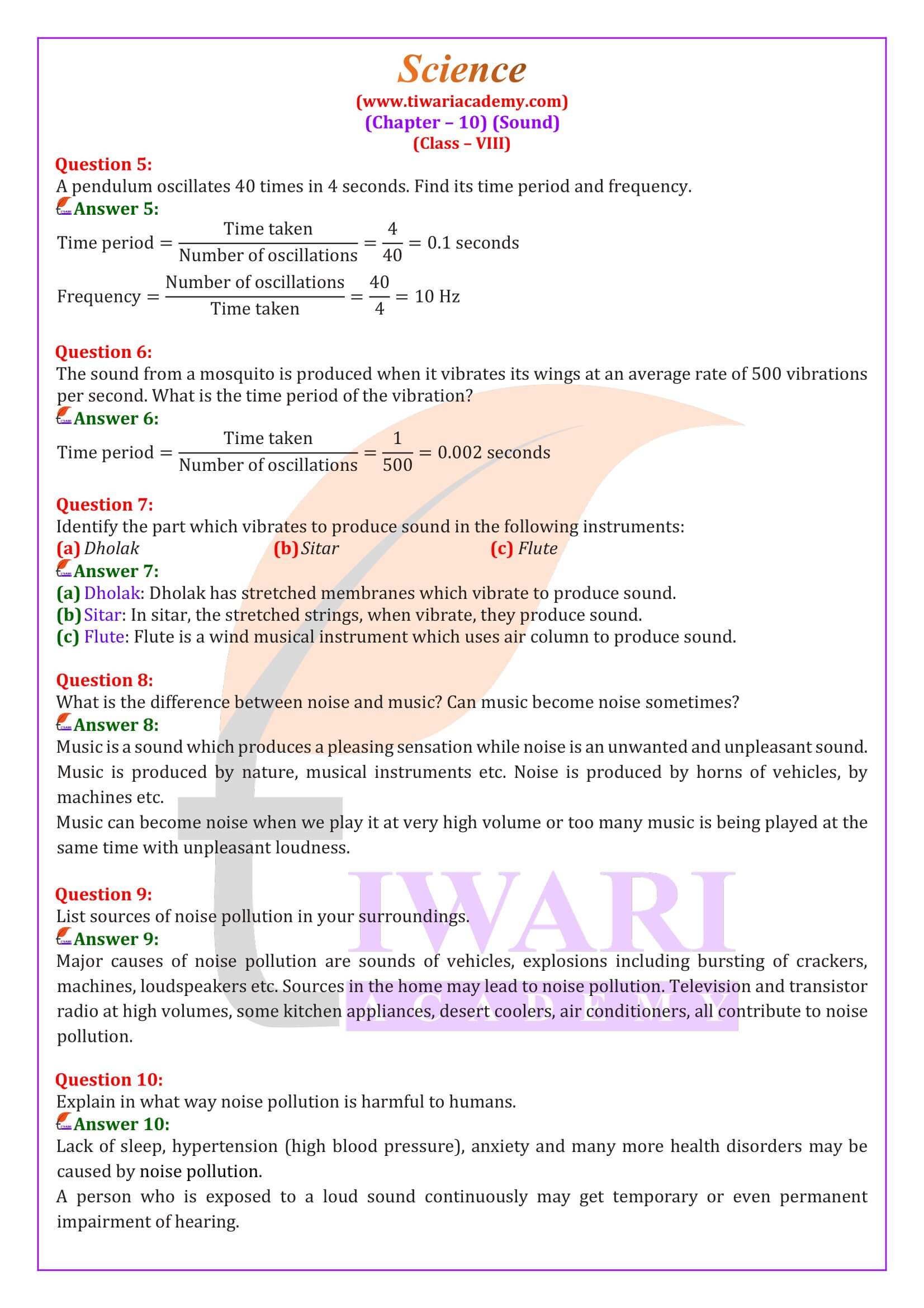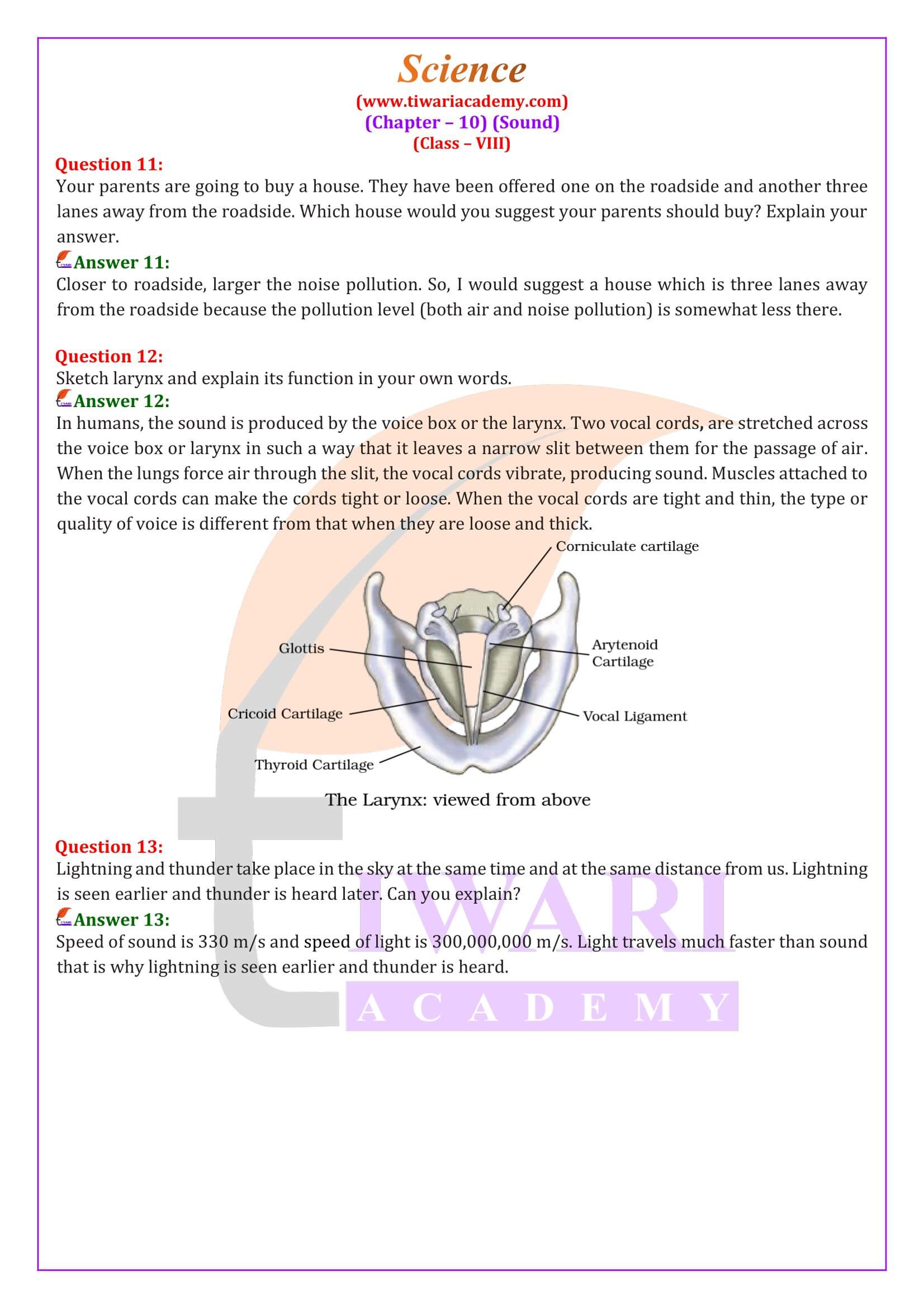Question Wise Class 8 Science Chapter 10 Solutions
Class 8 Science Chapter 10 NCERT Answers
Class 8 Science Chapter 10 in Hindi Medium
Class 8 Science Chapter 10 MCQ
Class 8 Science NCERT Book Download
Class 8 Science Chapter 10 Exemplar Book
Class 8 Science Chapter 10 Exemplar Answers
Class 8 Science NCERT Solutions
Class 8 all Subjects NCERT Solutions
NCERT Solutions for Class 8 Science Chapter 10 Sound in English and Hindi Medium to Study online and View in Video Format with download updated for academic session 2025-26 following new CBSE Syllabus and based on new NCERT Books. NCERT Solutions 2025-26 as well as Offline Apps of other subjects are also available.
| Class: 8 | Science |
| Chapter 10: | Sound |
| Content: | MCQ, Exercises and Extra Questions |
| Session: | 2025-26 |
| Medium: | Hindi and English Medium |
Class 8 Science Chapter 10 in English and Hindi Medium
- Class 8 Science Chapter 10 Question Answers
- Class 8 Science Chapter 10 in Hindi Medium
- Class 8 Science Chapter 10 MCQ
- Class 8 Science Chapter 10 NCERT Book
- Class 8 Science Chapter 10 Exemplar Book
- Class 8 Science Chapter 10 Exemplar Answers
- Class 8 Science NCERT Solutions
- Class 8 all Subjects NCERT Solutions
Class 8 Science Chapter 10 Solution and Explanation in Hindi
Class 8 Science Chapter 10 Answers
NCERT Solutions for Class 8 Science Chapter 10 Sound is given here. Video Format solution is also available. Download 8 Science App in Hindi Medium and English Medium for offline use for academic session 2025-26.
Class 8 Science Chapter 10 Solution and Explanation
Class 8 Science Chapter 10 Important Questions for Practice
List sources of noise pollution in your surroundings.
Major causes of noise pollution are sounds of vehicles, explosions including bursting of crackers, machines, loudspeakers etc. Sources in the home may lead to noise pollution. Television and transistor radio at high volumes, some kitchen appliances, desert coolers, air conditioners, all contribute to noise pollution.
Explain in what way noise pollution is harmful to humans.
Lack of sleep, hypertension (high blood pressure), anxiety and many more health disorders may be caused by noise pollution.
A person who is exposed to a loud sound continuously may get temporary or even permanent impairment of hearing.
What is the difference between noise and music? Can music become noise sometimes?
Music is a sound which produces a pleasing sensation while noise is an unwanted and unpleasant sound. Music is produced by nature, musical instruments etc. Noise is produced by horns of vehicles, by machines etc.
Music can become noise when we play it at very high volume or too many music are being played at the same time with unpleasant loudness.
Lightning and thunder take place in the sky at the same time and at the same distance from us. Lightning is seen earlier and thunder is heard later. Can you explain?
Speed of sound is 330 m/s and speed of light is 300,000,000 m/s. Light travels much faster than sound that is why lightning is seen earlier and thunder is heard.
Class 8 Science Chapter 10 MCQ with Answers
1. A list of mediums is given below.
(i) wood (iii) air (ii) water (iv) vacuum
In which of these mediums can sound travel?
(a) i & ii only
(b) i, ii & iii only
(c) iii & iv only
(d) ii, iii & iv only
2. Pitch of sound is determined by its
(a) frequency
(b) amplitude
(c) speed
(d) loudness
3. The loudness of sound depends on:
(a) its amplitude.
(b) its frequency.
(c) its time period.
(d) its speed.
4. An object is vibrating at 50 hertz. What is its time period?
(a) 0.02 s
(b) 2 s
(c) 0.2 s
(d) 20.0 s
5. The loudness of sound is determined by the
(a) amplitude of vibration
(b) ratio of amplitude and frequency of vibration
(c) frequency of vibration
(d) product of amplitude and frequency of vibration
6. In order to reduce the loudness of a sound we have to
(a) decrease its frequency of vibration of the sound.
(b) increase its frequency of vibration of the sound.
(c) decrease its amplitude of vibration of the sound.
(d) increase its amplitude of vibration of the sound.
7. 1 hertz is equal to
(a) 1 vibration per minute
(b) 10 vibrations per minute
(c) 60 vibrations per minute
(d) 600 vibrations per minute
8. Ultrasound has frequency of vibration
(a) between 20 and 20,000 Hz
(b) below 20 Hz
(c) above 20,000 Hz
(d) between 500 and 10,000 Hz
9. Which of the following statements are correct?
(i) Sound is produced by vibrations.
(ii) Sound requires a medium for propagation.
(iii) Light and sound both require a medium for propagation.
(iv) Sound travels slower than light.
(a) i & ii only
(b) i, ii & iii only
(c) ii, iii & iv only
(d) i, ii & iv only
10. Loudness of sound is measured in units of
(a) decibel (dB)
(b) hertz (Hz)
(c) metre (m)
(d) metre/second (m/s)
Answers of Important Questions (MCQ)
1 (b)
2 (a)
3 (a)
4 (a)
5 (a)
6 (c)
7 (c)
8 (c)
9 (d)
10 (a).
Download NCERT Books and Offline Apps 2025-26 based on new CBSE Syllabus. Ask your doubts related to NIOS or CBSE Board and share your knowledge with your friends and other users through Discussion Forum.




